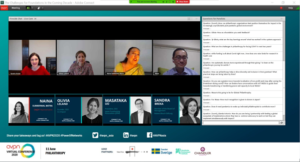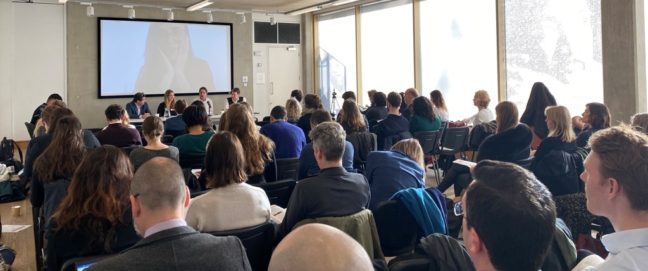The power of networks was the official theme of AVPN’s virtual 2020 conference, but, inevitably there was another theme too – the effects of the Covid-19 pandemic. It has torn up our intellectual maps and played havoc with our societies and our economies. The five days of the conference were each devoted to different themes – collaboration, gender, climate, philanthropy and impact investing. Naturally, these themes link and overlap and Covid-19 looms large behind them all. Phrases like ‘new normal’ and ‘build back better’ echoed and re-echoed over the conference airwaves. AVPN CEO and board chair, Naina Subberwal Batra in her opening remarks cited estimates which may well be conservative that the post-Covid recession would push forty to sixty million people into extreme poverty. We need to rethink and remake, she said, but not in the image of the old: ‘The time for innovative social development is now…it’s time to smash the status quo. We are all social investors now.’ Acumen’s Jacqueline Novogratz also evoked big ideas, speaking of the need to reimagine capitalism, to ‘change the definition of success’ and to cultivate our ‘moral imagination’.

AVPN panellists discuss challenges that foundations are facing in the coming decade?
A virtual conference?
One obvious effect of the pandemic was that the conference took place entirely online. The difficulties and the benefits of this will be the subject of a separate article, but for now let’s just observe some obvious effects: a number of speakers lamented that they weren’t physically in Singapore. People missed the face-to-face interaction and the ready ability to form relations around the sessions, but against that, many more people were able to take part. Some 7,400 people registered for the conference and as there were few concurrent sessions, they could take part in more of the 44 sessions. While they lacked the cut and thrust of live sessions, the virtual discussions were neither better nor worse than those in the flesh and in other ways, there was continuity. The AVPN’s deal share platform and its Connector app continued to function as they always do.
The pandemic should not absorb all our attention
So how are donors and investors responding to the pandemic? Tim Hanstad of the Chandler Foundation argued that foundations could and should ‘spend more and be more flexible [he noted that many were already doing so] … and more grantee-centric’. Many speakers noted that their foundations had moved quickly, raising emergency funds, or turning from their original aims to meet basic needs. The Hong Kong Jockey Club had revised its grants process, for example, that they were now turning round some applications within two weeks, said Leong Cheung, while the ABS CBN Foundation in the Philippines had repurposed some of the ecotourism projects it supports to become community foodbanks. What had come out of the crisis thought participants was a trend to collective giving, an accelerated use of digital technology and a focus on areas like health systems which clearly weren’t working. Iqbal Daliwal of research organisation J-PAL cautioned against allowing the pandemic to distract from funders from issues like climate change and poverty alleviation. Covid will cease to be a threat once a vaccine is discovered, he argued. The other two would continue to be ‘existential threats’. This was echoed throughout all the conference’s thematic tracks.
‘A magnifying glass’
If we hadn’t undertaken a strategic review over the past two years, Covid would have forced us to do so, said Sandra Breka of the Bosch Foundation. Her words will resonate with many foundations. In Bosch’s case, the rethink has been radical. They have gone from 55 programmes in five issue areas to 10 programmes in three areas and have overhauled their international programmes. What’s behind such a major change? Changes in the world – the prominence of issues like climate change, migration and inequality – and changes in philanthropy. There are more types of donor and more forms of donation and greater public attention has been called to philanthropy, challenging it to justify itself. Effectiveness and legitimacy alike demand the ‘highest degree of representation’ in a foundation’s consultations and decision-making. As for Covid, it has acted as a ‘magnifying glass’ – it has not changed Bosch’s objectives, it has thrown them into sharper focus. She also feels that in the short term, funding is likely to decrease so it’s even more important to see clearly where and how you can intervene. This was also urged by Olivia Leland of Co-Impact who said, this ‘is not the moment to pivot’, but to emphasise existing aims and objectives.
Thirty-eight per cent of impact enterprises last less than a year
James Chen of the Chen Yat Sen Family Foundation feels that the crux of philanthropy’s role in rebuilding is its attitude to risk. Philanthropy, particularly institutional philanthropy, is averse to risk. If you are an agent of capital rather than an owner, you start to suffer the institutional paralysis that often afflicts governments. This is the wrong approach to systems change. Before a commercial idea takes off, a long process of experimentation and failure is usually involved. It needs backers to go deep if it is to succeed. The same thing applies in the social sphere, he argued.
Collaboration – no option B
The overwhelming message from across the five days is that more collaboration is needed and that it should be multi-sector in form (a whopping 92 per cent of those taking part in an audience poll thought that collaborations across sectors were more likely to be effective than those within sectors). Quite simply, the problems facing all of us are too big and too complex for any individual entity to make more than a dent. Nearly all the panellists echoed this sentiment as did keynote speaker, Jacqueline Loh from Singapore’s Monetary Authority who spoke of the Authority’s approach to green infrastructural investing. Collaboration of course is the whole basis of AVPN. It is both exemplar and apostle of the idea and initiatives like its climate and gender platforms and its policy network – as well as its ability to attract keynote speakers like Ms Loh and José Viñals of Standard Chartered are testimony to its growing reach and ambition.
 There were special efforts at the conference to reach out to, and to stress the importance of, the private sector. However, the attitude of the development community towards business is often ambivalent – it is ‘in denial’, as Martin Short of Power of Nutrition put it, having been used to see corporations as the bogey. The private sector has a key role in engaging the public in changing habits and patterns of consumption, and in creating demand. Rezaul Bashar Siddique of the Ministry of Finance in Bangladesh also noted the dependence of his country on the contribution of the private sector if it is to achieve its goal of becoming a high-income, developed country by 2041.
There were special efforts at the conference to reach out to, and to stress the importance of, the private sector. However, the attitude of the development community towards business is often ambivalent – it is ‘in denial’, as Martin Short of Power of Nutrition put it, having been used to see corporations as the bogey. The private sector has a key role in engaging the public in changing habits and patterns of consumption, and in creating demand. Rezaul Bashar Siddique of the Ministry of Finance in Bangladesh also noted the dependence of his country on the contribution of the private sector if it is to achieve its goal of becoming a high-income, developed country by 2041.
And while collaboration is necessary it has its ups and downs. Neelam Chhiber spoke for many when she reminded us that ‘the foundation of collaboration is co-creation’. As Stephanie Arrowsmith of SecondMuse pointed out, you have to ‘check your ego at the door.’All agreed that collaborations, especially across sectors, need patience, trust and a shared vision if they are to work. but as Pradeep Nair of the Ford Foundation in India bluntly stated: ‘there is no option B’.
Social enterprise and the development toolkit
AVPN’s home turf is social enterprise and its social enterprise development toolkit (SEDT) is proving useful to early-stage SEs across the region. EY, which supports what it calls ‘impact enterprises’, uses the SEDT to complement its own tools and Savinda Ranathunga of the UNDP in Bangkok which supports youth enterprise development to address the SDGs in South East Asia has adapted the SEDT to help early-stage youth enterprises to assess themselves.
Thirty-eight per cent of impact enterprises last less than a year, said Jessie Coates of EY. They have three main challenges: first, they often go after the wrong kind of money. They need to think about what the money is for and where best to access it. Second, due diligence can be slow and stressful. Both side, investors and entrepreneurs, need to be clear about needs and expectations. Third, investment-readiness means different things to different people. Investors need to be clear about what they will invest in. Other panellists also dwelt on these points. Leon Toh of Damson Capital in Singapore emphasised the need for clarity in the due diligence process. There is no room for assumptions, he said. ‘If you can think of a question, you need to ask it.’
Nutrition
Less than 1 per cent of overseas development aid is spent on nutrition, said Martin Short, yet 150 million of the world’s under 5s suffer from some form of stunting. Forty per cent of pregnant women suffer from anaemia, which increases the risk that their child will be malnourished. Moreover, in the wake of the Covid crisis, any gains which have been made may be lost because health interventions have been focussed on the pandemic and because bilaterals will prioritise other areas. These things highlight the need to involve the private sector in more creative ways, he said.
Mandana Arabi of Nutrition International noted that the burden of the Covid crisis falls disproportionately on the poor and on women and girls (‘women eat last and least’, they shoulder the burden of care, their attendance at school suffers in a crisis and violence against women increases). The moral is, we can’t afford to wait for the pandemic to pass before we tackle malnutrition. And there are cheap interventions to hand. Fortification and maternal supplementation are critical to combat malnutrition as people’s income drops and their diet worsens as a result of the pandemic, said Yannick Foing of DSM, a business development organisation working in emerging markets to fight malnutrition. The cost of adding iron and folic acid to flour would cost USD0.12 per person per year!
Strategic leveraging of corporate resources for social impact
There were other pointers to the importance of the role of the private sector. Steven Serneels of EVPA cited a statistic that 85 per cent of giving in response to Covid has come from companies and, if NGOs are feeling financial pressure to look for income-generating activities and turn themselves into social enterprises, from the other side, business are under social pressure to create social impact. They are meeting in the middle, and starting to understand each other’s language. ‘We are seeing the rise of the corporate social investor,’ he said.
COVID has already led to change and, very strikingly, to greater use of technology which had in turn shown its potential to bring down costs and allow more efficient operation.
Jae-Ho Choi, head of CSR at Hyundai noted that CSR used to be giving, but that had proved unsustainable, so the company was now moving towards impact through social investment and collaboration. It’s H-Jump initiative in partnership with a Korean NGO was proving successful in enabling children from low-income families to access higher education through specialised teaching. What’s more employment among H-Jump’s alumni was 15 per cent higher than among non-alumni.
Gender – ‘we are still nowhere’
Development is also failing because it does not take sufficient account of gender inequality. This is especially true in Asia, feels Pranapda Phornphrapha of Dragonfly 360 in Thailand – ‘we are still nowhere’. Philanthropy can play a catalytic role, drawing attention to inequality and funding programmes for women’s empowerment. Networks are especially important because they can bring credibility, visibility and combined weight to the issue, but so, too, are role models and champions from popular culture. Young people in rural areas, for example, won’t have heard of NGO activists, but would hear if celebrities began to embrace the issue.
Gender lens investing (GLI) is still small in Asia but it’s growing, says Ayaka Matsumo of Japan’s Sasakawa Peace Fund, which in 2017 set up an impact investing fund from its endowment focused on women’s empowerment. When it was set up, GLI opportunities were far to seek. That’s changing quickly, especially in Japan. Suzanne Biegel of Catalyst At Large and Raya Papp of investment company Sagana both noted that emergent research suggested that not only was it growing, it spans a wide range of investors, asset classes and fields. The focus is no longer almost exclusively on women-owned businesses but on areas which have an impact on the livelihood and well-being of women across sectors as diverse as health, agriculture, education, ageing and even ocean health. Suzanne Biegel also observed that the growth of the sector hadn’t happened by accident. It needed and still needs champions and those who see the opportunity to tap into an underserved market for both normative and financial reasons, especially as women are likely to bear the brunt of the economic downturn – what Julia Newton-Howes of Investing in Women called a ‘she-cession’ – triggered by Covid.
While all the themes of the conference are interwoven, funding does not always effectively recognise that. There are ways for example of addressing both climate and gender issues at the same time. Because of its work with agri-business, for example, Meda, based in Canada, comes into contact with many women smallholder farmers and has become aware of the vulnerability of this group to climate change and so, over the last five years, has begun to see its investments and technical assistance through a gender lens. Still, though funding at this intersection is growing, as Katie Turner of Meda remarked, the level of integration of climate and gender investments is still ‘not where we hoped it would be’.
 The paramountcy of digital technology
The paramountcy of digital technology
Education, too, has felt the full force of the pandemic – and the children will continue to do so, especially those who are disadvantaged. A panel on the topic of education in India believes that the effects of school closures will affect the children involved for at least the next year and probably longer.
Meantime, Asia Pacific has 60 per cent of the world’s young people and 10.5 per cent of those are unemployed, so education and employment are critical. However, they need to change. The paradigm of quality education for the few and enough information to operate machinery for the rest is outdated. Education and training should not just be about employability, said Sebastien Marot of Friends International. Psycho-social skills will be as important as vocational skills. Another gap in the region is training and education for the differently-abled, pointed out Nicola Dean of Dubai Cares. On the positive side, COVID has already led to change and, very strikingly, to greater use of technology which had in turn shown its potential to bring down costs and allow more efficient operation. Safeena Husain of Educate Girls noted a greater appetite for the use of technology, an opportunity for policy change at the heart of any rebuilt system and a greater openness to collaboration among government departments.
For investors, the UN is an attractive proposition because of the scale it can operate on and because its large and very public presence
Similar considerations applied to healthcare. Dr Prem Pillay of Pureland Global Ventures, based in Singapore, gave the example of a hand-held device which could monitor pregnancy remotely, identify high-risk people, diagnose problems early and save lives. Veronica Colondam of YCAB in Indonesia which works with women’s micro-enterprise, sounded a warning. Most of YCAB’s clients have suffered a 50 per cent drop in income since lockdown. Seventy per cent of them sell food which has been hit hard, though many had adapted and are selling door-to-door. However, while technology can be crucial in allowing people to adapt quickly, only 25-30 per cent of YCAB’s clients have smartphones. This is a significant divide. ‘You can only innovate if you have access to the technology,’ she said. Nicola Dean echoed this saying that the unevenness of internet connectivity can reinforce inequalities. We must make digital connectivity a priority and make use of lower-tech means of remote learning like TV, radio and SMS.
River Warrior
A short video of Indonesian teenager Aeshnina Acqilani was billed as a highlight of the programme and it certainly was. She has taken her campaign to stop heads of governments in developed countries to stop them exporting waste to Indonesia because it is not disposed of safely. One of the results of this is that in the Brantas River that flows through her village of Bangun, 80 per cent of fish sampled have plastic in their stomachs.
In terms of climate, Dr Pushkala Lashmi Ratan of the International Finance Corporation (IFC) felt that if governments prioritise green finance in their response to Covid it would be good for both the climate and the economy. Innovation is happening, she argued, but more funding is needed. Shloka Nath of the India Climate Collaborative, launched this year, said that part of its rationale was not that climate solutions didn’t exist, but that people were working in siloes. Networks and collaborations bring visibility to issues, the opportunity to pool and to de-risk investments and more influence with policy-making circles. Nancy Smith of the Climate Action Pledge (CAP), also recently launched with the aim of bringing in an additional USD6 billion to climate funding, pointed out that the foundation sector’s involvement, as well as bringing money and influence, could also provide leadership, something that the sector ‘doesn’t recognise as much as it should.’
Threats to gastronomic treats
AVPN’s deal share platform showcased a number of social enterprises, backed by AVPN members, who are active in local climate solutions. One which stood out for the pleasing eccentricity and simplicity of its concept was that by Urchinomics on the cultivation of kelp forests through responsible urchin ranching. Kelp forests are the foundation of marine ecosystems, nourishing fish stocks and sequestering carbon. Certain kinds of sea urchins eat them, so Urchinomics’ project removes them, treats them in special facilities and sells them to seafood restaurants, turning them from pests to delicacies. The kelp forests can recover.
Money
Estimates are that meeting the SDGs will require an extra USD2.5 trillion a year in funding. It’s an eye-watering sum but Robert van Zwieten of Convergence pointed out that that’s only 1 per cent of the corpus of international capital markets and 14 per cent of global savings. The money is there. The question is how to lure it towards social investment, which of course, is what AVPN is all about.
There were sessions on different ways of doing this. The APAC region is home to a very large Muslim population, yet Islamic funding is a largely untapped source and Khaled Khalifa of UNHCR noted that the principles of Zakat were perfectly aligned with the SDGs and that UNHCR’s Refugee Zakat Fund had reached one million displaced people last year and that estimates of the annual corpus of Zakat vary between USD300 billion and 1 trillion. Even on the conservative end, it’s a large pool of funding that could potentially address development issues.
The pandemic has thrown the spotlight on the critical role digital technology can and will continue to play
Badlishah Bashah of the Malaysian Securities Commission noted the progress in issuing green Sukuk bonds which are Shariah-compliant. The Malaysian government is taking steps to clarify which projects are eligibile for green Sukuks and is offering grants and tax incentives to encourage their take-up and, since their introduction in 2017, green Sukuks have raised some USD1 bn, nearly all of for public-private partnerships.
Impact investing
James Griffin of Credit Suisse and Florian Heeb of CSP in Zurich gave what was almost a tutorial on impact investment, dispelling misconceptions and demystifying terminology along the way. They pointed out that ‘it’s not what you own it’s what you cause.’ Investment in a ‘brown’ company in order to influence it to become more green might be more effective in the long run than investing in a green company that is already has plenty of access to capital. It’s important that investors decide whether the investee company has a positive impact and whether their shareholding will make a difference to that impact. They also pointed out what James Chen noted earlier – impact is proportional to risk, so if you want to have impact, you have to take risks.
But it increasingly makes financial as well as ethical sense, Cindy Ko of Toniic cited a survey the organisation had done of its 100 per cent network, Toniic members who have committed to aligning all of their investments with their values, which found that the financial expectations of 82 per cent of those surveyed had either been met or exceeded. Keynote speaker José Viñals, chair of Standard Chartered Bank agrees. Investing in sustainability is ‘not only the right thing to do, it’s the smart thing to do.’
Public-private partnerships (PPPs)
It might seem surprising at first sight that UNHCR invests in climate mitigation. As Olaf Tchongrack explained, it’s because climate change is now contributing to displacement and the conflicts, which refugees are fleeing, exacerbate climate change and environmental degradation. However, UNHCR’s ‘greening’ efforts which include planting 19 million trees, put a big strain on its budget and tie up resources which might go to its more direct life-saving work. It is therefore engaging in partnerships with donors, development banks and investors to fund its environmental work. This is one example of an increasing openness of all sectors to engage in financing partnerships. For investors, the UN is an attractive proposition because of the scale it can operate on and because its large and very public presence is reassuring for the risk-averse.
In its wholesale dismantling of practices and assumptions, the pandemic offered the opportunity to create a more resilient, a fairer and a more human system
In a closing session, Naina Batra talked to Angela Tanoesoedibjo, Vice-Minister of Tourism and the Creative Economy in Indonesia. The Vice-Minister highlighted once again the links between sustainable development, economic development and the empowerment of women, noting that Indonesia was focussing on promoting tourism with pay-offs in all of these areas. She also underlined the extent to which the pandemic has thrown the spotlight on the critical role digital technology can and will continue to play.
Overall, bad as the situation is in some respects, there was optimism. In its wholesale dismantling of practices and assumptions, the pandemic offered the opportunity to create a more resilient, a fairer and a more human system but it would require cooperation and recognition of common purpose. Above all, as Sebastien Marot of Friends International said, if we are to build systems that are fairer and more serviceable, funders and investors need to be ready to support their partners and investees to allow them to experiment otherwise we will end up with a reflection of what Covid has swept away.
To end on a lighter note, my mind goes back to the Urchinomics’ urchin ranching project and its conceptual simplicity. If only all of our problems were so readily identifiable and so delightfully – for some – compatible.
Andrew Milner is associate editor of Alliance magazine






Comments (0)